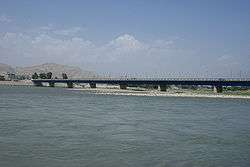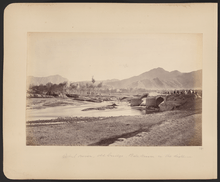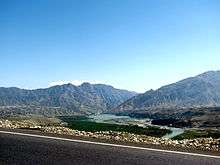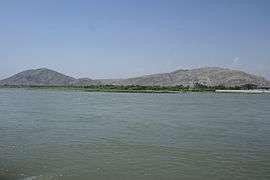Kabul River
The Kabul River (Pashto: د کابل سیند; Persian: دریای کابل), the classical Cophes /ˈkoʊfiːz/, is a 700-kilometre (430 mi) long river that emerges in Maidan Wardak Province in the Sanglakh Range of the Hindu Kush mountains in Afghanistan, and is separated from the watershed of the Helmand River by the Unai Pass. The Kabul River empties into the Indus River near Attock, Pakistan. It is the main river in eastern Afghanistan and the Khyber Pakhtunkhwa province of Pakistan.
| Kabul | |
|---|---|
 | |
 | |
 Mouth of the Kabul River in Pakistan | |
| Location | |
| Country | Afghanistan |
| City | Kabul, Surobi, Jalalabad (Afghanistan); Peshawar, Charsadda, Nowshera (Pakistan) |
| Physical characteristics | |
| Source | Hindu Kush Mountains |
| ⁃ location | Maidan Wardak Province, Afghanistan |
| ⁃ coordinates | 34.357°N 68.8392°E |
| ⁃ elevation | 2,400 m (7,900 ft) |
| Mouth | Indus River |
⁃ location | Attock, Punjab, Pakistan |
⁃ coordinates | 33°55′0″N 72°13′56″E |
| Length | 700 km (430 mi) |
| Basin size | 66,000 km2 (25,000 sq mi) |
| Basin features | |
| Tributaries | |
| ⁃ left | Panjshir River, Alingar River, Kunar River, Swat River |
| ⁃ right | Logar River, Surkhab River, Bara River |
Course
The Kabul River passes through the cities of Kabul, Surobi, and Jalalabad in Afghanistan before flowing into Khyber Pakhtunkhwa in Pakistan some 25 kilometres (16 mi) north of the Durand Line border crossing at Torkham. In Khyber Pakhtunkhwa, the river passes through the cities of Peshawar, Charsadda, and Nowshera. In its upper reaches it is known as the Sarchashma.[1]
The major tributaries of the Kabul River are the Logar, Panjshir, Alingar, Surkhab, Kunar, Bara, and Swat rivers.

Hydrology
The Kabul River is little more than a trickle for most of the year, but swells in summer due to melting snows in the Hindu Kush Range. Its largest tributary is the Kunar River, which starts out as the Mastuj River, flowing from the Chiantar glacie in Brughil valley in Chitral, Pakistan and after flowing south into Afghanistan it is met by the Bashgal river flowing from Nurestan. The Kunar meets the Kabul near Jalalabad. In spite of the Kunar carrying more water than the Kabul, the river continues as the Kabul River after this confluence, mainly for the political and historical significance of the name.
Dams
The Kabul River is impounded by several dams. The Naghlu, Surobi, and Darunta dams are located in the Kabul and Nangarhar provinces of Afghanistan. The Warsak Dam is in the Valley of Peshawar in Pakistan, approximately 20 km northwest of the city of Peshawar.
History
Etymology
Gallery
 The Kabul River in the city of Kabul, 1982
The Kabul River in the city of Kabul, 1982 The Kabul River in the city of Kabul in 2009, now dried up
The Kabul River in the city of Kabul in 2009, now dried up The dried river in the central city of Kabul
The dried river in the central city of Kabul Kabul River valley
Kabul River valley Gorge of the Kabul River, parallel to the Kabul-Jalalabad Road
Gorge of the Kabul River, parallel to the Kabul-Jalalabad Road Kabul River in Behsood Bridge Area, Jalalabad, 2009
Kabul River in Behsood Bridge Area, Jalalabad, 2009 Kabul River in Behsood Bridge Area, Jalalabad, 2009
Kabul River in Behsood Bridge Area, Jalalabad, 2009 Buddhist caves, which have been carved into a set of cliffs on the north side of the Kabul river
Buddhist caves, which have been carved into a set of cliffs on the north side of the Kabul river
References
- "One Land, Two Rules (9): Delivering public services in insurgency-affected Jalrez district of Wardak province". Afghan Analysts Network. 16 December 2019. Retrieved 30 April 2020.
- Arrian, John Rooke; Arrian (1813). "A brief account of all the authors who have touched upon the history of Alexander". Arrian's History of the expedition of Alexander the Great: and conquest of Persia. Translated by Rooke, John (2nd ed.). J. Davis.
- Cawthorne, Nigel (2004). Alexander the Great. Haus Publishing. ISBN 1-904341-56-X.
- Heckel, Waldemar (2003). The wars of Alexander the Great, 336-323 B.C. Taylor & Francis. ISBN 0-415-96855-0.
- Arrian (2005). Romm, James S. (ed.). Alexander the Great: selections from Arrian, Diodorus, Plutarch, and Quintus Curtius. Translated by Mensch, Pamela. Hackett Publishing. ISBN 0-87220-727-7.
- The History and Culture of the Indian People : The Vedic age. By Ramesh Chandra Majumdar, Achut Dattatrya Pusalker, A. K. Majumdar, Dilip Kumar Ghose, Bharatiya Vidya Bhavan, Vishvanath Govind Dighe Published by Bharatiya Vidya Bhavan, 1962 Page 247|quote=The Kubha is the modern Kabul river which flows into the Indus a little above Attock and receives at Prang the joint flow of its tributaries the Swat (Swastu) and Gauri
- Original Sanskrit Texts on the Origin and History of the People of India By John Muir page 352|quote='In the older parts of the Rigved the Indian people appear to be settled on the north western border of India, in the Punjab and even beyond the Punjab on the borders of the Kubha river the Kowpher in Kabul. The gradual diffusion of these people from this point towards the east, beyond the Saraswati and Hindustan as far as the Ganges, can be traced almost step by step in the later portions of the Vedic writings
- Bosworth, C.E. (1999). "Kabul". Encyclopaedia of Islam (CD-ROM Edition v. 1.0 ed.). Leiden, The Netherlands: Koninklijke Brill NV.
External links
- . Encyclopædia Britannica (11th ed.). 1911.
| Wikimedia Commons has media related to Kabul River. |